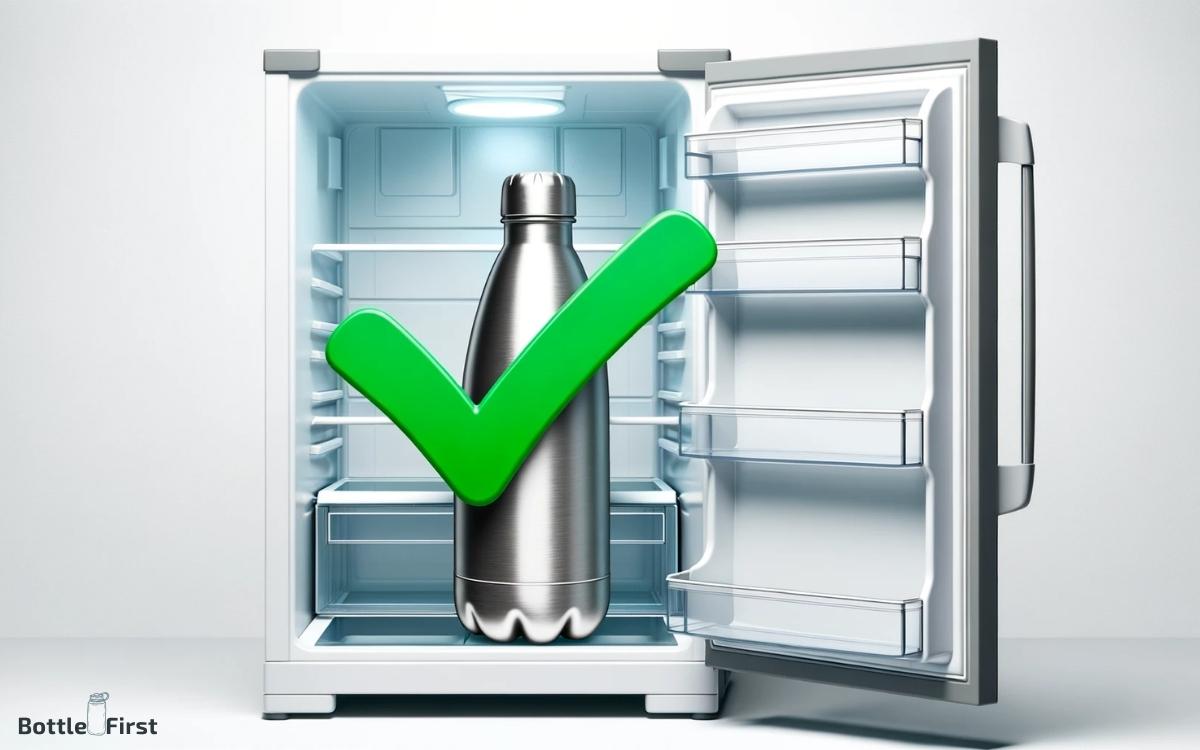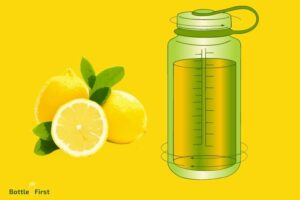Can You Put a Metal Water Bottle in the Fridge? Yes!
Yes, you can put a metal water bottle in the fridge. Metal water bottles are designed to handle a range of temperatures and refrigeration will not damage the bottle’s structure or cause harm to your health.
Metal water bottles, often made from stainless steel or aluminum, are built to endure both hot and cold temperatures.
The materials used in these bottles are non-reactive and do not leach chemicals when exposed to cold environments, making them safe for refrigerator use.
Here’s what to consider:
- Material Durability: Stainless steel and aluminum have high tensile strength and can withstand temperature changes without warping.
- Health and Safety: Quality metal bottles are typically BPA-free and do not release harmful substances.
- Insulation Properties: Insulated metal bottles can keep your drinks cold for extended periods, even outside of the fridge.
For example, if you fill a stainless steel water bottle with water and place it in the fridge, it will cool without any impact on the bottle’s material or safety.
Storing your metal water bottle in the fridge is not only safe but also ensures a refreshing drink on a hot day, without compromising the quality or safety of your hydration solution.

Key Takeaway
The Science of Metal and Cold
The behavior of metal in response to low temperatures has long been a subject of scientific inquiry.
When metal is subjected to cold temperatures, its atomic structure undergoes changes that can affect its mechanical properties.
At lower temperatures, metals tend to become more brittle due to a decrease in atomic mobility and an increase in the forces holding the metal’s crystalline structure together. This can lead to an increase in the likelihood of fracture or failure under mechanical stress.
Understanding the behavior of metals at low temperatures is crucial for various innovative applications, such as in the aerospace and energy industries, where materials are often exposed to extreme cold environments.
Researchers continue to explore new alloys and treatments to mitigate the negative effects of low temperatures on metal, driving innovation in material science and engineering.
Potential Impact on Bottle Integrity
When it comes to placing a metal water bottle in the fridge, the potential impact on bottle integrity is a crucial consideration.
The fridge temperature can affect the metal, potentially causing changes in the bottle’s structural integrity.
Additionally, condensation forming on the metal surface due to temperature variations may also influence the bottle’s overall integrity.
Fridge Temperature and Metal
Fridge temperature’s potential impact on metal water bottle integrity is a critical consideration for maintaining the bottle’s quality and safety.
When it comes to storing a metal water bottle in the fridge, here are three important factors to consider:
- Material Resilience: Exposing the metal bottle to extremely low temperatures for extended periods can lead to metal fatigue, compromising its structural integrity.
- Condensation Control: Fluctuating temperatures inside the fridge can cause condensation to form on the exterior of the bottle, potentially leading to corrosion over time.
- Thermal Shock: Sudden temperature changes, such as removing a cold metal bottle from the fridge and placing it in a warm environment, can cause the metal to expand and contract rapidly, potentially weakening the bottle’s structure.
Understanding these aspects is crucial for preserving the metal water bottle’s durability and ensuring its long-term functionality.
Transitioning into the subsequent section about ‘condensation and metal’, it’s essential to explore how condensation affects the integrity of a metal water bottle.
Condensation and Metal
Transitioning from the previous subtopic about the potential impact of fridge temperature on metal water bottle integrity, it is crucial to delve into the effects of condensation on the bottle’s structural integrity.
Condensation, a natural occurrence when a metal water bottle is placed in the fridge, can potentially impact the bottle’s integrity.
The presence of condensation on the exterior of the bottle can lead to moisture accumulation, which, over time, may result in the development of rust or corrosion. This can compromise the structural integrity and overall quality of the bottle.
To mitigate this issue, innovative solutions such as double-walled vacuum insulation can be employed to prevent condensation from forming on the exterior of the bottle.
Additionally, utilizing high-quality stainless steel materials with corrosion-resistant properties can further safeguard the bottle’s integrity against the effects of condensation.
Temperature-Related Health Concerns
Temperature stability is crucial for maintaining the integrity of beverages stored in metal water bottles. Sudden temperature changes can impact the composition of the liquid inside and pose potential health risks.
Here’s what you need to consider:
- Chemical Leaching: Extreme temperature fluctuations may cause the metal to leach harmful chemicals into the beverage. This can compromise the quality and safety of the drink.
- Bacterial Growth: Inconsistent temperatures can create an environment conducive to bacterial growth. This can lead to contamination of the beverage and potential health issues upon consumption.
- Thermal Shock: Rapid temperature variations can cause thermal shock, potentially leading to structural damage to the metal bottle, which may result in the release of harmful substances into the liquid.
It is essential to maintain a stable temperature for the safety and quality of the beverages stored in metal water bottles.
Condensation and External Factors
Are there external factors that contribute to condensation and affect the integrity of beverages stored in metal water bottles?
When considering the impact of condensation on metal water bottles, external factors such as temperature variations, humidity levels, bottle design, and insulation play a crucial role.
These factors can affect the amount of condensation that forms on the exterior of the bottle and impact the temperature and quality of the beverage inside.
| External Factors | Impact |
|---|---|
| Temperature Variations | Rapid temperature changes can lead to increased condensation. |
| Humidity Levels | Higher humidity can result in more condensation on the bottle surface. |
| Bottle Design | Insulated bottles may reduce condensation due to temperature differentials. |
| Insulation | Improved insulation can minimize the impact of external temperature changes. |
Understanding these external factors can aid in the development of innovative solutions to mitigate condensation and maintain beverage quality in metal water bottles.
Cooling Benefits of Metal Bottles
Metal water bottles offer superior cooling benefits due to their excellent thermal conductivity and ability to retain low temperatures for extended periods.
The innovative design and material properties of metal bottles make them ideal for keeping beverages refreshingly cool.
Here are three key cooling benefits of metal water bottles:
- Rapid Cooling: Metal bottles have high thermal conductivity, allowing them to quickly transfer the coldness from the fridge to the liquid inside, ensuring a swift cooling process.
- Long-lasting Coldness: Once cooled, metal bottles can maintain low temperatures for an extended time, providing a prolonged cooling effect even in warm environments.
- Minimal Heat Transfer: Unlike other materials, metal bottles minimize heat transfer from the surroundings, preserving the beverage’s temperature for longer periods.
With these exceptional cooling benefits, metal water bottles are a top choice for those seeking a reliably chilled drink on the go.
Best Practices for Refrigeration
Refrigeration of metal water bottles requires careful consideration to ensure optimal cooling performance and beverage quality maintenance.
To maximize the benefits of refrigerating metal water bottles, it is essential to follow best practices.
The table below outlines these best practices for refrigerating metal water bottles:
| Best Practices | Details |
|---|---|
| Use Insulated Bottle | Choose a metal water bottle with double-wall insulation to maintain the cold temperature for a longer duration. |
| Avoid Freezing | Do not freeze the metal water bottle to prevent potential damage to the bottle and maintain the quality of the beverage. |
| Pre-chill Beverage | Pre-chill the beverage before pouring it into the metal water bottle for enhanced and faster cooling. |
| Proper Placement | Place the metal water bottle in the coldest part of the refrigerator to ensure efficient cooling. |
Alternative Storage Options
When it comes to alternative storage options for metal water bottles, room-temperature storage and the use of insulated cooler bags are worth considering.
These options can be especially useful for outdoor activities, picnics, or when refrigeration is not readily available.
Exploring these alternatives can help maintain the temperature and quality of the water in the metal bottle.
Room Temperature Storage
Some people prefer to store their metal water bottles at room temperature, as it is commonly recommended by manufacturers for daily use.
Room temperature storage offers several benefits, including:
- Retaining the natural taste of water without any influence from temperature fluctuations.
- Avoid condensation that can occur when bottles are moved between different temperature environments, which can be inconvenient and potentially damaging to electronic devices or paperwork in a bag.
- Ensuring that the bottle is always ready for use without the need to wait for it to reach a desirable temperature.
Use Insulated Cooler Bags
Insulated cooler bags offer a practical alternative for storing your metal water bottle while maintaining its temperature.
These innovative bags are designed to keep the contents either hot or cold for an extended period, making them an ideal choice for preserving the temperature of your metal water bottle.
Here’s a comparison table to help you choose the right insulated cooler bag for your needs:
| Feature | Standard Insulated Cooler Bag | Advanced Insulated Cooler Bag | Premium Insulated Cooler Bag |
|---|---|---|---|
| Temperature Range | Keeps items cold for 12 hours | Keeps items cold for 24 hours | Keeps items cold for 48 hours |
| Durability | Basic insulation | Enhanced insulation | Superior insulation |
| Portability | Standard size and weight | Lightweight and compact | Spacious and easy to carry |
Investing in an insulated cooler bag ensures that your metal water bottle maintains its temperature, providing you with a refreshing drink whenever you need it.
Conclusion
In conclusion, refrigerating a metal water bottle can result in a refreshing and invigorating experience, akin to a cool breeze on a hot summer day.
However, it is important to consider the potential impact on the bottle’s integrity and the risk of condensation.
By following best practices for refrigeration and exploring alternative storage options, individuals can ensure their metal water bottle remains in optimal condition while still enjoying the cooling benefits.
Frequently Asked Questions
Can Putting a Metal Water Bottle in the Fridge Affect the Taste of the Water?
Storing a metal water bottle in the fridge can impact taste due to potential metal leaching. Stainless steel bottles are a better choice as they are non-reactive. Ensure the bottle is BPA-free for optimal taste preservation.
Will Refrigerating a Metal Water Bottle Cause It to Sweat or Create Condensation on the Outside?
Refrigerating a metal water bottle may cause condensation to form on the outside due to the temperature difference between the cold contents and the ambient air. This is a normal occurrence and does not affect the bottle’s functionality.
Is There a Risk of the Metal Water Bottle Freezing and Causing Damage to the Bottle?
Refrigerating a metal water bottle may risk freezing and damaging the bottle. Innovatively, consider using insulated sleeves or double-walled bottles to mitigate this risk. This approach ensures the preservation of the bottle’s integrity and the beverage’s temperature.
Are There Any Concerns About the Metal Leaching Into the Water When Refrigerated?
Refrigerating a metal water bottle may raise concerns about potential metal leaching into the water. However, most stainless steel bottles are designed to be safe for refrigeration. To ensure safety, it’s advisable to check the manufacturer’s guidelines.
What Are the Best Alternatives to Refrigerating a Metal Water Bottle for Keeping Drinks Cold?
To keep drinks cold without refrigerating a metal water bottle, consider using insulated bottle sleeves, cooling towels, or portable ice packs. These alternatives maintain the beverage’s temperature and are convenient for on-the-go use.






